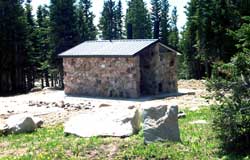Why Snow Load Information?
A great deal of confusion currently exists among engineers, architects,
recreation specialists, and maintenance personnel concerning the proper
snow loading to use for the design and maintenance of trail bridges,
building roofs, and other structures in mountainous, high snow load
areas.
Snow loads are influenced by elevation, general weather and moisture
patterns, slope direction, exposure, roof (or trail bridge) configuration,
and wind direction and severity.
Overestimation of snow loads can unnecessarily increase the cost
of construction. Underestimation of snow loads can result in premature
failure, high maintenance costs, resource damage, and, in some cases,
safety issues.
Summer and winter photographs of the same building.
 |
 |
| These
photos were taken by Roxie Baldwin in 2002 at
Mirror Lake on the Medicine Bow-Routt National Forest.
The site is located in
the Snowy Range Mountain Range in Wyoming at an elevation of
approximately 10,500
feet. |
Purpose of This Web Site
The purpose of this Web site is to provide ground
snow load analysis
information and data gathered from all 50 States. Each state has
a listing of
building code and applicable guidelines for snow loads, as well as
details about where the snow load information may be found or purchased.
Please refer to the International Building Code (IBC) (http://www.iccsafe.org/e/category.html)
or ASCE 7, Minimum Design Loads for Buildings and Other Structures
(http://www.pubs.asce.org/)
for roof snow load determination and
requirements.
Acknowledgements
James Scott Groenier, Project Leader,
Email: jgroenier@fs.fed.us
Mary Trankel, Web Development, Email: mtrankel@fs.fed.us
Sara Lustgraaf, Graphic Designer
Shanon Boehlke, Web Assistant
Project proposed by: Merv Eriksson, Regional
Bridge Engineer, Region 6, USDA Forest Service
Disclaimer
The USDA Forest Service hereby gives notice that the information
herein contained shall not create any warranty, expressed or implied.
The person or organization using this information waives and relinquishes
any and all claims against the United States of America, its officers,
employees, and project cooperators, for any loss, damage, personal
injury, or death incidental to, or occurring as a consequence of,
the use thereof.
The use of trade, firm, or corporation names in this Web site is
for the information and convenience of the reader. Such use does
not constitute official endorsement or approval by the U.S. Department
of Agriculture of any product or service to the exclusion of others
that may be suitable.
We appreciate your interest. If you have any questions, or would
like further assistance, please contact Scott
Groenier at the Missoula
Technology and Development Center at (406) 329-4719 or jgroenier@fs.fed.us. |

 National
National

